What is a 72-hour emergency bug-out pack?
Many people have never heard of a 72-hour emergency bug-out pack. It is a pre-prepared kit that’s designed to give you what you need for the next three days if you must leave your home. It’s supposed to be a self-contained kit that gets you through the next 72 hours of your journey.
In most cases, 72 hours is all you need to find government relief or get to an area that isn’t part of the evacuation location. It’s also not unusual that in extreme cases aid can take up to three days to reach once mobilized to the worst affected areas of any disaster. This is why it pays to be prepared!
In this article we will talk a little about the contents of a 72-hour emergency kit and it’s importance. For those of you that may be in a hurry you can download our printer friendly bug-out pack checklist here.
Who Will Benefit From Having an Emergency Kit or Bug-Out Pack?
Many people do not want to be caught unaware or be in an emergency situation without the right tools for survival. Everyone, regardless of where they live, can benefit from having a bug-out bag packed and ready for any situation. This includes having one for small children and your pet, yes they count too! I personally like having a tactical backpack as you can add a little more to the outside using the molle.
Typical and Essential Contents
Creating a bug-out bag is essential so that you are prepared, but it’s also important that you have the right contents. These can include but aren’t limited to:
Water
Of course, water is one of the most important things to have in your bag. You never know when you’ll come across clean water, especially if a natural disaster happens. To stay properly hydrated throughout the day, each person in the household needs at least one liter of water. However, keep in mind that you might be hiking or it might be extremely hot.
Therefore, more is always better. For a three-day BOB (bug-out-bag), you will need at least three liters of water for every person.
Water Filtration Systems
While having an adequate supply of water is important, you just never know how thirsty you’ll be, and you don’t want to ration water. Proper hydration is important because you don’t know what’s going to happen.
Dehydration can cause headaches, lethargy, and fatigue. You’re already upset that you have to leave and an emergency situation arose, so it’s best to have many water options available.
A water filtration system can help you turn any water source into drinkable water. You never know what contaminants are lurking in even the most pristine waters. You wouldn’t want to get an upset stomach in a disaster situation!
Water Bottle or Bladder
Bladders can be smaller and easier to carry, but they are harder to fill up. You can fill the bladders with water and keep them near your emergency kit to grab when it’s time. However, you may not be able to refill the bladder on the go, especially if there is no potable water around.
Water bottles may be a better choice because they aren’t as likely to leak. Plus, they’re easier to fill up. Depending on the style you buy, it might also be easier to pour water into the bottle from another container. With that said most good EDC backpacks come with a separate pouch to hold a water bladder which makes it easier to carry over a water bottle.
Portable Water Pouches
Portable and collapsible water containers or pouches are another excellent choice. You can purchase pouches that are already filled; all you have to do is open it and drink. These are easy to pack in small spaces within your emergency kit and usually have a shelf life of around 5 years. There are also soft pouches that are available empty; fill them yourself and store them as part of your preparedness kit or even as part of your food storage.
Food
While water is essential for life, food is up high on that list, as well. You could go for three days without food, but it wouldn’t be pleasant. You can find a variety of foodstuffs available, some of which can be found at your local grocery store.
Energy Bars/Tablets
When we say energy bars, we don’t mean those foo-foo granola bars you get at the store. While you can have a few of those on hand, the goal is to save space and have nutritional food items. You can find 2400 calorie food bars on the market now.
These bars are enriched with vitamins and minerals giving you a good source of energy and nutrition that your body might need during this time. They are easy to eat, so it feels like you’re doing something normal, but one bar has all the calories you need for the day for most people. Food tablets are also available, though you probably think it’s a thing of the future.
You can find a variety of manufacturers nowadays that offer these items. However, they vary widely in calories and flavors. Therefore, you may want to read the descriptions of each product you consider and maybe try them before you pack them into your kit.
Meal Replacement Pouches (MRE or Meals, Ready-to-Eat)
Meal replacement pouches are another convenient item to have with you. Called MRE or Meals, Ready-to-Eat, these packages contain a full meal. The good thing is that they don’t require any preparation; you don’t even have to add water with some of them. They’re sturdy and energy-dense, giving you the energy needed to walk long distances, run, or walk on rough terrain.
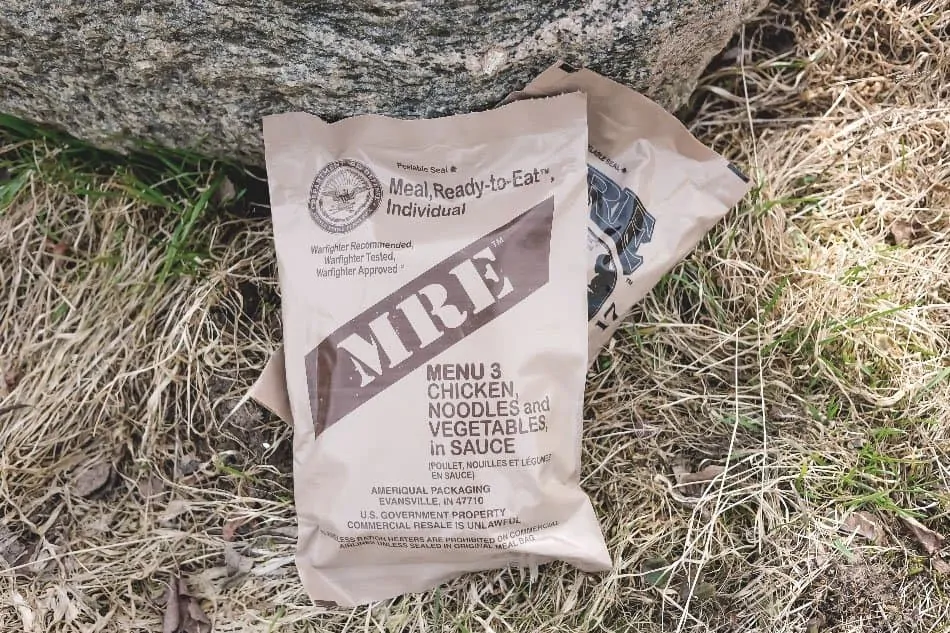
Heating and Cooking
In most cases, you’re going to try to have full, ready-made meals available for an emergency kit. You don’t know if you’ll find meat, if that meat will be fresh, and if you’ll be able to cook it or not.
If you want to be as prepared as possible, you may consider having a camping-style grill or stove and an appropriate heat source. You can find mini cooking stoves that use gas; you can easily set it up, warm up or cook food on, and put it away.
There are many ultralight portable outdoor backpacking or camping style stoves that can form part of your emergency kit.
Can Opener
Canned food can seem like a tasty treat after eating nothing but MREs and energy bars. You can choose a variety of canned foods that can be cooked over a camp stove. These include beans, soups, and more. You can also find pre-cooked meats, such as SPAM, canned chicken, canned tuna, and others.
Canned spaghetti are favourites with little children so keep this in mind if keeping up spirits and smiles is on the agenda. Just make sure you pack a manual can opener or two because you won’t be able to get to the yummy goodness without it.
Be sure that the can opener is a survival style can opener so that you’re not adding undue weight to your kit that you’re going to be carrying around.
A P-38 can opener comes to mind.

Shelter
While you hope that wherever you’re going has accommodation that you’re used to, you never know what you’ll come up against before you get to civilization. You may be in an area that is totally devastated or if you’re fortunate be somewhere that hasn’t been touched by the emergency situation – you never know! Therefore, it’s best if you consider the many shelter options available so that you can decide which one is right for you.
Tent
You can find a variety of tents on the market, but when you’re looking for one, there are a few things to consider. If you and the family plan to stay in one tent, it’s going to have to be big enough for you all to fit comfortably. Because you’re trying to conserve space and make the bug-out bag as light as possible, you may want to consider pop-up tents that don’t require any poles.
It’s going to be easier to set up, but it’s also going to save space in the bag. Remember, this is an emergency situation and although comfort is important, sacrifice is necessary even if just for three days. Ensure you have a disaster preparedness checklist.
Bivi Bag
A Bivi bag is a waterproof inner for sleeping bags. It’s usually thin and waterproof. and easy to roll up. You put it over your sleeping bag and can use it instead of a tent. Some people do use Bivi bags as sleeping bags. You can do this, but it is thinner than a traditional sleeping bag, which might make it uncomfortable, especially if you’re sleeping on the ground or in cold conditions.
Tarp
While you’ve got the best waterproof tent, sleeping bag, and/or Bivi bag, it can still be helpful to have a tarp. What happens if your sleeping bag or tent gets torn or stops being waterproof? You don’t want to be susceptible to the elements. A tarp (along with some rope) can quickly turn any tree into a shelter. You can drape the tarp over the tree and create a lean-to, keeping it tied down to prevent it from blowing away in the wind. Having a tarp for survival shelter is a must!

Sleeping Bag
You should also have a sleeping bag for yourself and all family members. If you already have one, it’s best to buy another one because this sleeping bag should never leave the bug-out bag. That way, you don’t forget where you put it after your last camping trip and don’t risk it getting torn or ripped before the big emergency happens.
Fire and Warmth
Regardless of what the situation is, you’re out on your own, or you’re trying to get to a location that is safe, so you need a variety of things. Food, water, and shelter are the top three things, but you also need warmth and fire. If you’re going to be in the wilderness (or think you might), you need fire. Even if it’s the heat of summer, you need a fire to keep away predatory animals.
Even in summer, the nights can get very cool; you may want a fire to keep you and the family warm, as well. One fire can do both unless you have a large group. In that case, you may want a few fires in a circular pattern with the group in the middle to provide protection and warmth.
Lighter
Having a lighter is essential. While you can create fire with flint and wood, the process is time-consuming, and you’re better off spending that time setting up camp. Lighters should be stored in a waterproof plastic baggie to ensure that it will work when you need it.
Matches
While a lighter is the best option, and you may want to have two or three of them, they can stop working or get wet. Matches can be a suitable alternative to light a fire quickly, as well. Keep three or four books in a waterproof container or waterproof plastic baggie. There are also waterproof matches on the market so get these if you are looking for some.
Tinder
You’re probably going to find tinder out in the wilderness, but not if it’s been raining. You should keep some tinder with you and store it in waterproof containers or baggies. Options can include real cotton balls, dryer lint mixed with a little petroleum jelly, and newspaper. There are also waterproof tinder options available so look out for these too.
Ferro Rods
These are a great alternative to the above and are very effective at starting fires. Ferro is short for Ferrocerium which is a synthetic alloy which creates sparks when struck. These sparks are used for starting fires.
Candles
Candles may not keep you warm, but they can shed some light. They can provide a small flame with the wick, which might be easier to light. From there, you could use the candle to light the tinder or kindling, but be careful! Candles also offer light which might be needed while playing your card game to keep occupied or reading a map at night. You should try conserve any battery powered torches where possible.
Foil Blanket
You should also keep a foil blanket for each member of the family. They can counteract or prevent hypothermia (when the body gets too cold to function). If you’re caught out in the rain and/or wind, you’re likely to experience the chills. Wrap a foil blanket around you to preserve your warmth and warm back up steadily.
First Aid, Health, & Hygiene
It’s important that you have appropriate health and hygiene products, as well as a first aid kit. You never know when you’ll get injured. You also want to stay clean to prevent infection, which means you need appropriate hygiene products.
Kids love plasters, for the silliest things I might add so keep plenty of these on hand too!
First Aid Kit
You can purchase a pre-packaged personal first aid kit almost anywhere. Make sure it has adhesive bandages, gauze dressings, eye dressings, and antibacterial ointment. It might also have latex gloves, scissors, and other odds and ends. Be sure to check the expiry dates of the items within your first aid kit from time to time.
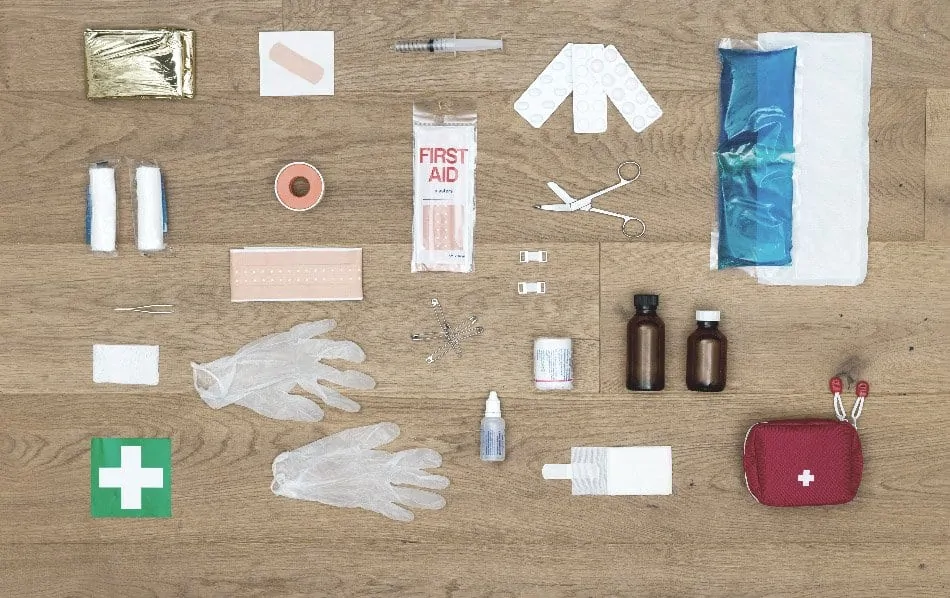
Prescription Medications
If you take prescription medications or anyone in your family does, it is essential to have a week’s supply that you keep in your bug-out bag. If possible, you may ask for a month’s extra to keep on hand, though many doctors and pharmacists prefer not to do that. If you cannot get extra to store then try keep a prescription on hand.
Non-Prescription Medicines
Non-prescription medicines can include ibuprofen or acetaminophen, as well as nose spray, OTC allergy medication, and much more. You never know when you might get a head-ache, your water supply might be running low and you may be a little dehydrated. If you take supplements, it is best to have them on hand, as well.
Hand Sanitizer
If you’re in the wilderness, you don’t want to wash your hands with contaminated water, but you don’t want to use your potable water. Hand sanitizer is the next best thing. If your hands are soiled, wash them with baby wipes (see below) and finish with hand sanitizer, using it as directed. Hand sanitizer is also flammable; you can squirt a little on the fire to help keep it alive.
Baby Wipes
Again, if your hands are dirty and there are no clean, running water sources, it might be best to clean your hands with baby wipes. You can also clean your body with baby wipes to prevent infection from contaminated water sources. Staying clean can also have an uplifting effect on your mood in what might be an already trying situation.
Feminine Hygiene
If you’re a woman or are traveling with women, it is important to have appropriate feminine hygiene products because you never know when your menstruation and an emergency will coincide. It’s best to purchase the products you normally use, but you should also have a box of tampons on hand. If you don’t usually use them, you can use them as tinder or kindling in a pinch.
Lighting
While it’s usually safer not to travel at night, you may need to do so, or you may want to have light at night to play games and try to relax. You can find a variety of lighting options that are suitable for the wilderness.
Flashlight
Each person in the party should have a flashlight. You can find the extremely bright ones that are strong enough to cut through the darkest night. It’s also important to have plenty of batteries for the light. Periodically, test the battery and flashlight to make sure it works, but always put it back in your bug-out bag.

Glow Sticks
Glow sticks are suitable when you’re in a rush and need light quickly. You pull one out, crack it, and get illumination. They aren’t very bright, but they can help you see to untie a knot and do minor things that require light. They usually also last a few hours.
Headlamp
If you must travel at night, everyone should have a headlamp. It fits on the head like a baseball cap and illuminates what’s in front of you. It should be checked periodically to ensure that there are no loose connections, but remember to put it back in your BOB. They’re also great at keeping your hands free. Remember, you might be climbing, carrying extra items or a small child or animal. Keeping your hands free might just be required.
Protection and Self Defense
You must be prepared for anything, and that includes protecting yourself and your family. Self-defense is always okay in our book, and in most cases, you won’t get in trouble with local law enforcement, especially if you fear for your life and are in an emergency/crisis situation.
Pepper Spray
Pepper spray is an excellent deterrent. Many would-be thieves see the can and immediately back off. If not, spraying them in the eyes (or anywhere, really), causes a burning sensation and blinds them temporarily, allowing you and your family to get away.
Hand Gun
Yes, a handgun is an essential protective tool. You probably have a few that you like, but make sure the one you choose is easy to handle, easy to carry, and easily concealed. Also, make sure you have enough bullets. I personally like a crossbow, there’s something apocalyptic looking about holding one in your hands!
Communication
You and your family are likely to get separated at some point in your journey. Hopefully this is not the case. You need a way to communicate, and multiple methods are better.
Mobile Phone
Make sure everyone has their cell phone. Most people keep it on them at all times anyway, so that shouldn’t be an issue. However, mobile phones aren’t always the best way to communicate; the phone system in your area is likely to go down first, especially if you’re under attack. An EMP or electromagnetic pulse can also render your phone useless.
Wind-Up Radio
If you need to hear what’s going on in other parts of the area or want to get news, a wind-up radio is your best bet. While you may have a radio in your car/truck, you may have to abandon it. Some stations are likely to play music, which can help alleviate the mood and keep people calm, as well.
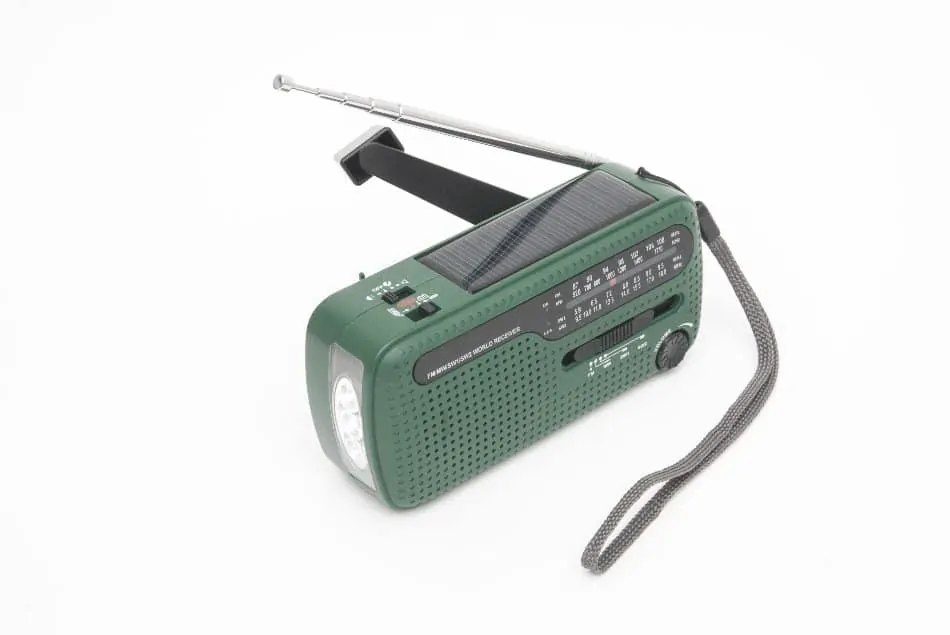
Walkie-Talkie
A walkie-talkie for each person ensures that everyone can talk even if someone gets separated. Make sure that you all know what channel to be on and ensure that the walkie-talkie gets the range listed on the packaging.
Satellite Phone
While expensive, a satellite phone can come in handy. If phone lines are down and internet connections go down, you can still communicate with the outside world. Consider calling a local law enforcement agency or a government agency to try to get information.
Power Essentials
Don’t forget that if you are carrying any electrical devices that you will need to keep them charged. You either want to go with a hand crank or wind up device or you’ll want to carry adequate power with you. This could be additional batteries or as Ross from The Solar Advantage says, “Solar charging power banks can come in handy. Adding a secondary source of energy for a low cost is an easy win.”
Tools
Your bug-out bag needs to have a variety of tools that are easily accessible, including:
Mini Folding Shovel with Axe
Pack a mini folding shovel with an axe. You can use the axe to chop wood. The shovel can be used to bury trash or kill a fire or even dig a small hole to prop up tree branches if you’re making a shelter. I’ve often heard it said that it’s one of the best items to have in your bug-out bag.
Multi-Tool
A multi-tool is essential because it has many tools that you may require.
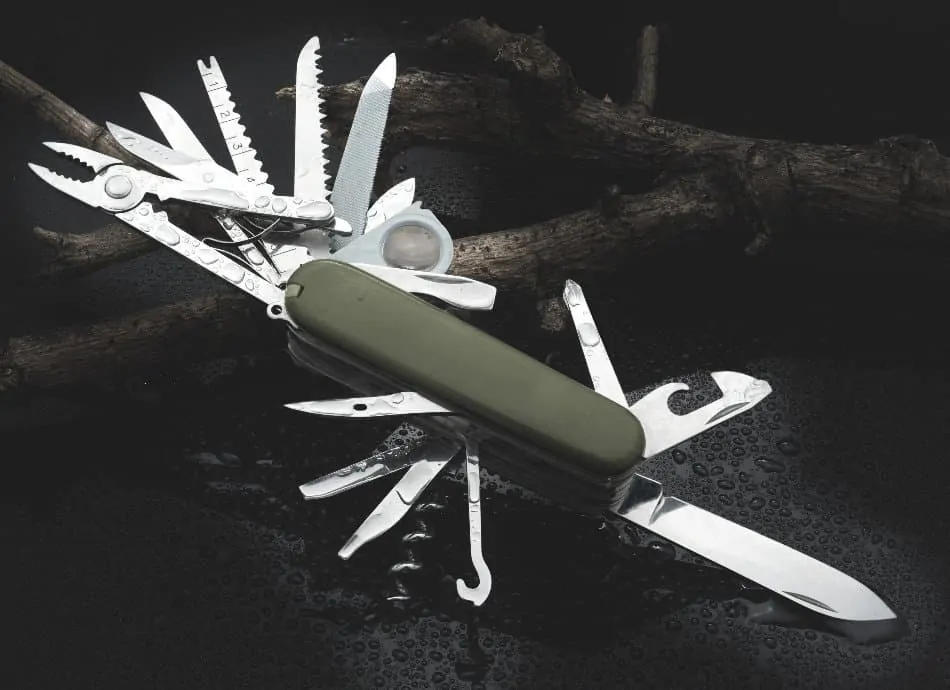
It’s likely to have a small knife, bottle opener, scissors, wire stripper, screwdriver, and more. If you’re the type that never leaves home without a multi-tool, you may not need to include this in your bug-out bag. However, it can be helpful to have extra sets on hand because you never know if one will get lost or given to another group on the road.
550 Paracord
Ah, 550 paracord! It’s our best friend because it does so much. It can be used as fishing line, snares, lanyards, and so many other things. We don’t think there’s anything that 550 paracord can’t do or fix, but we are a little biased. You can find thousands of tutorials and articles about the benefits of paracord.
We recommend that you keep multiple bundles of it in your bug-out bag and throughout your house!
Duct Tape
Duct tape can also be used for many things. You can use it to repair your tent, make a rope, reseal food, splint broken poles, create a shelter, and so much more! You’ve heard that duct tape can fix anything and if it can’t, it’s broken beyond repair and now you know why! Keep a couple of rolls of duct tape in your BOB, which should be kept separate from your household duct tape.
Fishing Kit
Fresh food isn’t a necessity, but if you have the time, catching fish can be a fun way to break the tension. You can find fishing kits for survival, which come in a container with many lines, lures, and hooks. You’ll still need the pole, but you can find many portable (small) options such as those in an Altoids tin survival kit specifically with fishing contents.
It might be best to look for a pole with its own carrying case. The pole itself is likely to be expensive, and you want to protect it from getting broken while you’re grabbing your bug-out bag and running for the hills (or your SUV).
Signalling and Navigation
GPS isn’t likely to work, and you may need to signal a helicopter for help. You can’t expect roadway signs to be present and magnetic energy from a natural disaster could cause digital compass-style tools to go haywire. In these instances, you need a few tools, such as:
Maps of Local Area
You should have a paper map of your area. Make sure the map includes details about your safe location, as well. You can usually find maps at the tourist center. You can also ask around at fishing/bait shops, gun stores, and hunting shops. They’re sure to have maps of many areas. You may want to grab a couple so that you can mark them on your journey or make notes of water/food options in case you get lost or end up backtracking. Make sure to include a waterproof pouch to keep them in.
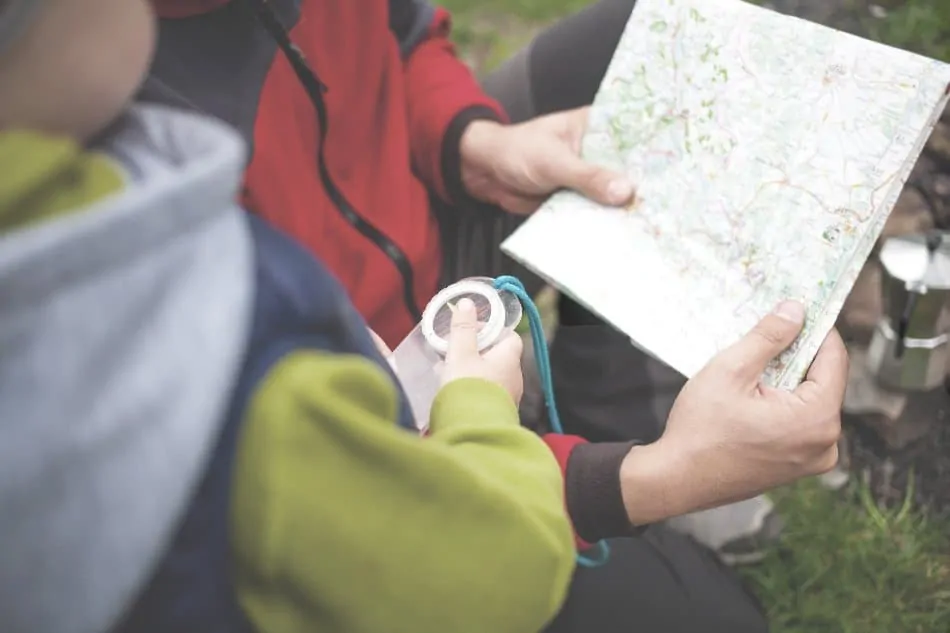
Compass
A compass is helpful. If you must go through the woods, it’s easy to get lost. Tornados can also tear away directional markings, leaving you clueless as to which way you’re going. The compass should be a simple design; you don’t need all the foo-foo digital readouts. It’s best to use an old-school compass and make sure that it points true north before packing it in your BOB.
Beacon
Having a portable beacon is helpful if you get in trouble. It makes sounds to attract attention to your location. This is helpful if you get stranded in a flood or become injured and can’t walk. You can find a variety of beacons available, some of which are lightweight or handheld. Make sure it is loud enough to be heard from a great distance; if you can shout louder than the beacon, it’s not going to help you much in the wilderness.
Whistle
A whistle can also summon help to you. It’s also helpful if any of your party gets lost. They can blow on the whistle and stay in one place until you find them. Make sure the whistle is made of durable material. Plastic is fine for toys, but you should get stainless steel whistles for everyone in the family or group to be stored in the bug-out bag.
Along with such, you may want to purchase whistles with stretchy bands so that they can be worn around the wrist and are easily accessible for when they’re needed most.
Orange Blanket
An orange blanket is conspicuous, so it can be used to attract help to you. It can also help you stay warm and may protect you from getting shot by a hunter thinking you are an animal. If you’re not feeling threatened at the time, you can also lay it down to act as a cushion when you and the group take a break between hikes.
Mirror
A mirror is another way to signal for help. If you can catch the sun’s rays and direct it with your hand to a person’s field of vision, they will notice, and you can holler for help. If you get separated from your group and get a cut on your back (or something similar), you can also use the mirror to see injuries on the back part of your body.
Personal Items
You should have appropriate personal items with you in case you seek help from the government.
Cash
Cash is going to be king in an emergency because power is likely to be out. Make sure you keep between $500 and $1000 in your bug-out bag. You can use it to purchase supplies. If it comes down to it, you can buy information and other things, as well. Remember, price gouging is likely to happen during these situations.
Passport
If the crisis lasts for too long, you and your family could get bussed to Canada or Mexico. In this case, you’re going to need your passports to prove that you’re Americans. Everyone in your group (even children) should have a recent passport. They should be stored in a waterproof container to keep them safe. Unless you’re a frequent traveller you should keep your passport with your emergency kit at all times.
Contact Numbers
You should keep a list of contact numbers, such as family members, local law enforcement numbers, and the like. It should not be kept on your phone. Write or type/print a list and laminate it if possible. If possible try and memorize these.
Family Photos
Recent family photos are important; if you and your loved ones get lost, you can show pictures of them to help you relocate them after a natural disaster or upheaval. Of course, most passports include a picture, so that offers dual functionality. However, if you meet up with another group, you shouldn’t whip out your passport; it’s too valuable because it’s needed for verification purposes.
Document Copies
Keep copies of your essential documents, such as driver’s license, medical information, social security card, bank account numbers, and your gun permit. These should be stored in a waterproof container and should be located ‘deep’ in your bug-out bag. You don’t want them to fall out when you reach for something because you don’t want this information getting into the wrong hands. You could also keep a copy of these on a flash drive as a secondary precaution.
Clothing
Yes, you are going to be wearing clothes when the ‘big’ event happens (whatever that may be), and you need to bug out fast. However, it’s essential that you have one or two changes of clothes. You don’t know when you’ll get to civilization, and dirty clothes can breed harmful bacteria.
Change of Clothing
It’s important to have a change of clothing or two for everyone in the family. You may also want to have extra underwear and socks. You can buy things if you’re heading through town, but it’s likely to be more expensive with the crisis. Remember, these items should stay in the BOB, so you shouldn’t wear them.
You should focus on comfortable, cotton-style clothing. You may also want to consider moisture-wicking clothes that remove sweat and moisture from the body to keep you dry and cooler. Also pack something warm but lightweight.
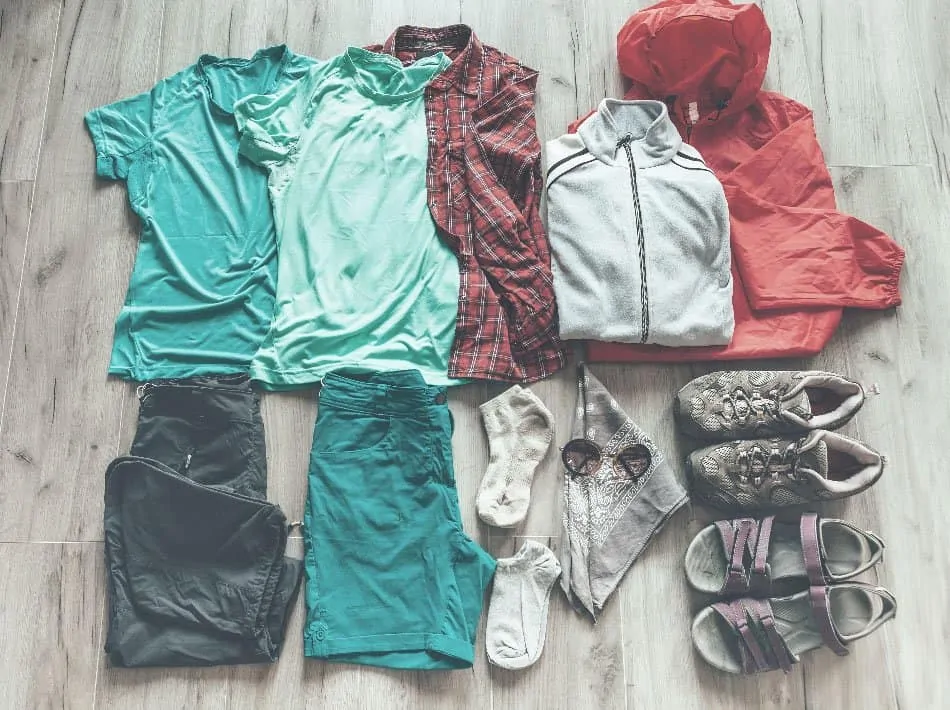
Walking Shoes
You don’t know what time you’ll have to get out of your house and you may not have time to change shoes. Make sure each family member has a pair of walking shoes that stay in the bug-out bag. For adults, this may not be a significant issue because adult’s feet rarely change much. However, whenever you buy new shoes for your children, make sure to buy an extra pair of walking shoes for the BOB and remove the old ones from the pack.
Packing for Children
If you have children, it is important to pack appropriately for them. Depending on their lifestyle habits, you may want multiple changes of clothes and underwear. You should also make sure they have any medications they need, as well as a stuffed animal or security blanket.
While we will talk more about the type of pack you should use, each child should have their own bug-out bag with their name on it. That way, you can easily change out clothes and shoes as your children grow. Don’t forget to include a few fun things for them, they will be easily affected by the disaster situation and keeping them happy will help morale.
Entertainment
Phones shouldn’t be used as toys during a crisis situation. Make sure you have portable board games, a deck of cards, coloring books/crayons, and anything else that is easy to transport that your children like. If possible, you’re going to take your car or family vehicle for as long as possible. Children can play in the backseat or read books while you and any other adults focus on getting to safety.
The Pack Itself
If possible, try to have all of the items to put in the pack together, so you can see how much stuff you have. You want as few bags to carry as possible. It is ideal for each person in the family or group to have his or her own pack, including children. An over the shoulder tactical messenger bag can be a little uncomfortable to carry for long periods.
Remember, young children may not be able to walk all day and carry a pack, so other adults may have to switch out. You can’t expect your children to do everything you do, but you need to pack just as much for them as everyone. There are two ways to go about packing your items. You can choose to pack all the food/water in one bag and all the fire-making/food-catching items in another. Then, each person can have a personal pack for personal things.
Another way to pack is to pack enough food/water/fire tools/etc. for one person in each bag. There are pros and cons of both options, but most people want to have some of everything in each pack. If you somehow lose the pack with all the food and water, you’re going to be in serious trouble really quickly. If your pack is ‘self-sufficient’ in that it has all the items you need then getting separated will not be a problem either.
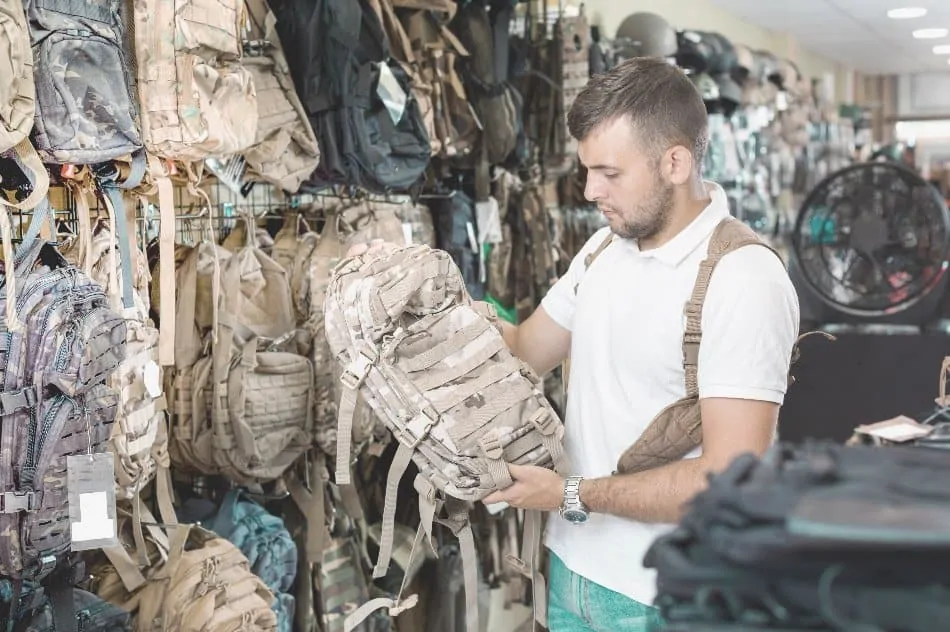
Lightweight and Comfortable Carry
The bag should have a comfortable grip; you can also choose backpack-style bags that are easier to transport and leave your hands free. The bag itself should be light, as you’ll be packing a lot in it. Once the pack is filled, trial carry it and make sure that it is comfortable and that you are strong enough to manage it.
Tactical or Not?
The best tactical backpack can be helpful because they have a variety of nooks and crannies where you can store things. Plus, they look like backpacks and can make it easier to carry. Choose ones with orange strips to help you get noticed if necessary. Most tactical style backpacks come with molle webbing which allow for further pouches to be attached. This makes it easier to grow your pack and also ‘shed’ your pack as items are used. Take a look at our guide to choosing a tactical backpack.
Packing for Your Pets
Let’s not forget our furry friends, they too need looking after just like your children. After all they cannot fend for themselves, someone’s got to pack an emergency kit for them too. There is a great pet preparedness article that’s been prepared by FEMA in consultation with The American Society for the Prevention of Cruelty to Animals (ASPCA) which highlights some of the key points to consider when preparing a disaster pack for your pet.
Aside from the obvious like food and water supplies, they suggest keeping a backup leash, and a collar with ID tag in your pets emergency kit. Copies of registration and vaccination documents as well as any medical records should also be placed in a waterproof container.
Consider how you are going to travel with your pet in toe. Do you need a sturdy carrier? Can you handle the carrier, your child and your pack as well as their emergency supplies? It’s worth doing a practise run if you can so you know what to expect in the event of an emergency.
Conclusion
Having a 72-hour emergency bug-out bag is essential. It has everything you need in a convenient grab-and-go bag. That way, you’re not scrambling around for important things when you need to vacate your home quickly. Make sure you check the contents every six months or so to make sure nothing has expired such as food, water and and medical supplies.
Also continually asses your needs and make sure they contents remain appropriate. Don’t forget to download our printer friendly bug-out pack checklist here and make sure to keep safe. Remember, chance favours the well prepared!
I’m Nebojša, a seasoned digital marketing professional with over 15 years of experience. My writing covers a diverse range of topics, from technology and gaming to app development and automobiles, all while delving into the intricacies of SEO optimization. Beyond the digital realm, I find solace in nature, inherited from my father’s love for the outdoors. His passion for hunting has influenced me, adding another layer to my appreciation for the natural world.